Xin Xia
Reasoning Efficiently Through Adaptive Chain-of-Thought Compression: A Self-Optimizing Framework
Sep 17, 2025Abstract:Chain-of-Thought (CoT) reasoning enhances Large Language Models (LLMs) by prompting intermediate steps, improving accuracy and robustness in arithmetic, logic, and commonsense tasks. However, this benefit comes with high computational costs: longer outputs increase latency, memory usage, and KV-cache demands. These issues are especially critical in software engineering tasks where concise and deterministic outputs are required. To investigate these trade-offs, we conduct an empirical study based on code generation benchmarks. The results reveal that longer CoT does not always help. Excessive reasoning often causes truncation, accuracy drops, and latency up to five times higher, with failed outputs consistently longer than successful ones. These findings challenge the assumption that longer reasoning is inherently better and highlight the need for adaptive CoT control. Motivated by this, we propose SEER (Self-Enhancing Efficient Reasoning), an adaptive framework that compresses CoT while preserving accuracy. SEER combines Best-of-N sampling with task-aware adaptive filtering, dynamically adjusting thresholds based on pre-inference outputs to reduce verbosity and computational overhead. We then evaluate SEER on three software engineering tasks and one math task. On average, SEER shortens CoT by 42.1%, improves accuracy by reducing truncation, and eliminates most infinite loops. These results demonstrate SEER as a practical method to make CoT-enhanced LLMs more efficient and robust, even under resource constraints.
Adversarial Distribution Matching for Diffusion Distillation Towards Efficient Image and Video Synthesis
Jul 24, 2025
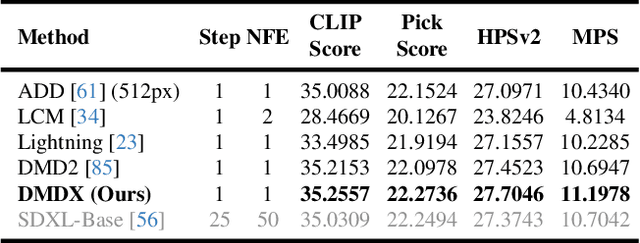
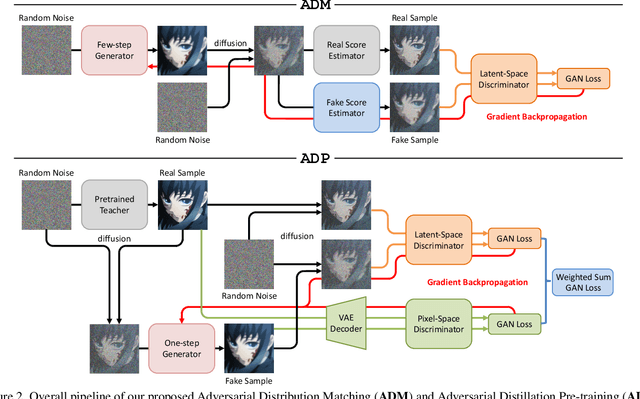
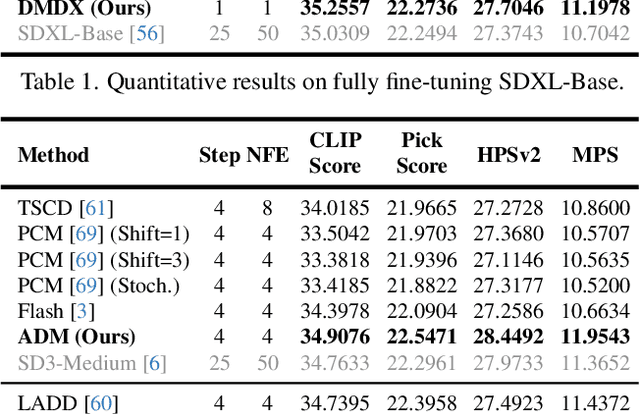
Abstract:Distribution Matching Distillation (DMD) is a promising score distillation technique that compresses pre-trained teacher diffusion models into efficient one-step or multi-step student generators. Nevertheless, its reliance on the reverse Kullback-Leibler (KL) divergence minimization potentially induces mode collapse (or mode-seeking) in certain applications. To circumvent this inherent drawback, we propose Adversarial Distribution Matching (ADM), a novel framework that leverages diffusion-based discriminators to align the latent predictions between real and fake score estimators for score distillation in an adversarial manner. In the context of extremely challenging one-step distillation, we further improve the pre-trained generator by adversarial distillation with hybrid discriminators in both latent and pixel spaces. Different from the mean squared error used in DMD2 pre-training, our method incorporates the distributional loss on ODE pairs collected from the teacher model, and thus providing a better initialization for score distillation fine-tuning in the next stage. By combining the adversarial distillation pre-training with ADM fine-tuning into a unified pipeline termed DMDX, our proposed method achieves superior one-step performance on SDXL compared to DMD2 while consuming less GPU time. Additional experiments that apply multi-step ADM distillation on SD3-Medium, SD3.5-Large, and CogVideoX set a new benchmark towards efficient image and video synthesis.
Autoregressive Adversarial Post-Training for Real-Time Interactive Video Generation
Jun 11, 2025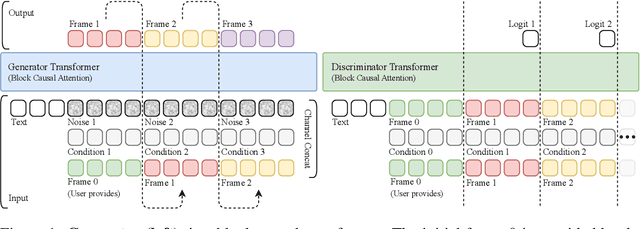
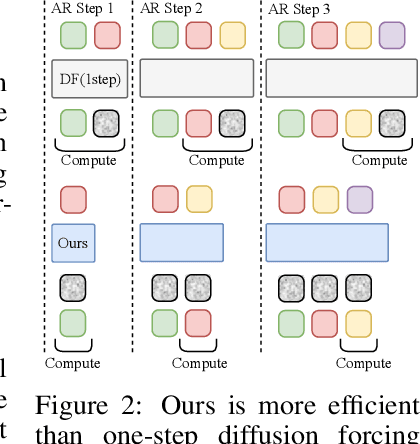

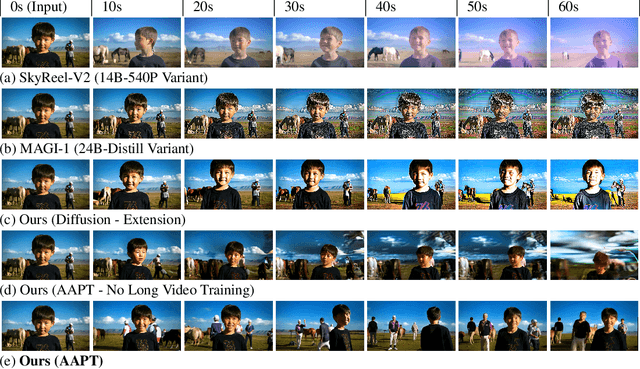
Abstract:Existing large-scale video generation models are computationally intensive, preventing adoption in real-time and interactive applications. In this work, we propose autoregressive adversarial post-training (AAPT) to transform a pre-trained latent video diffusion model into a real-time, interactive video generator. Our model autoregressively generates a latent frame at a time using a single neural function evaluation (1NFE). The model can stream the result to the user in real time and receive interactive responses as controls to generate the next latent frame. Unlike existing approaches, our method explores adversarial training as an effective paradigm for autoregressive generation. This not only allows us to design an architecture that is more efficient for one-step generation while fully utilizing the KV cache, but also enables training the model in a student-forcing manner that proves to be effective in reducing error accumulation during long video generation. Our experiments demonstrate that our 8B model achieves real-time, 24fps, streaming video generation at 736x416 resolution on a single H100, or 1280x720 on 8xH100 up to a minute long (1440 frames). Visit our research website at https://seaweed-apt.com/2
SeedEdit 3.0: Fast and High-Quality Generative Image Editing
Jun 06, 2025Abstract:We introduce SeedEdit 3.0, in companion with our T2I model Seedream 3.0, which significantly improves over our previous SeedEdit versions in both aspects of edit instruction following and image content (e.g., ID/IP) preservation on real image inputs. Additional to model upgrading with T2I, in this report, we present several key improvements. First, we develop an enhanced data curation pipeline with a meta-info paradigm and meta-info embedding strategy that help mix images from multiple data sources. This allows us to scale editing data effectively, and meta information is helpfult to connect VLM with diffusion model more closely. Second, we introduce a joint learning pipeline for computing a diffusion loss and reward losses. Finally, we evaluate SeedEdit 3.0 on our testing benchmarks, for real/synthetic image editing, where it achieves a best trade-off between multiple aspects, yielding a high usability rate of 56.1%, compared to SeedEdit 1.6 (38.4%), GPT4o (37.1%) and Gemini 2.0 (30.3%).
Seedream 3.0 Technical Report
Apr 16, 2025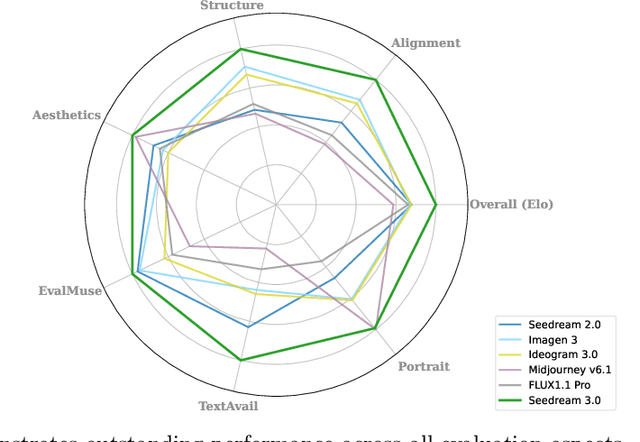



Abstract:We present Seedream 3.0, a high-performance Chinese-English bilingual image generation foundation model. We develop several technical improvements to address existing challenges in Seedream 2.0, including alignment with complicated prompts, fine-grained typography generation, suboptimal visual aesthetics and fidelity, and limited image resolutions. Specifically, the advancements of Seedream 3.0 stem from improvements across the entire pipeline, from data construction to model deployment. At the data stratum, we double the dataset using a defect-aware training paradigm and a dual-axis collaborative data-sampling framework. Furthermore, we adopt several effective techniques such as mixed-resolution training, cross-modality RoPE, representation alignment loss, and resolution-aware timestep sampling in the pre-training phase. During the post-training stage, we utilize diversified aesthetic captions in SFT, and a VLM-based reward model with scaling, thereby achieving outputs that well align with human preferences. Furthermore, Seedream 3.0 pioneers a novel acceleration paradigm. By employing consistent noise expectation and importance-aware timestep sampling, we achieve a 4 to 8 times speedup while maintaining image quality. Seedream 3.0 demonstrates significant improvements over Seedream 2.0: it enhances overall capabilities, in particular for text-rendering in complicated Chinese characters which is important to professional typography generation. In addition, it provides native high-resolution output (up to 2K), allowing it to generate images with high visual quality.
InSPE: Rapid Evaluation of Heterogeneous Multi-Modal Infrastructure Sensor Placement
Apr 11, 2025Abstract:Infrastructure sensing is vital for traffic monitoring at safety hotspots (e.g., intersections) and serves as the backbone of cooperative perception in autonomous driving. While vehicle sensing has been extensively studied, infrastructure sensing has received little attention, especially given the unique challenges of diverse intersection geometries, complex occlusions, varying traffic conditions, and ambient environments like lighting and weather. To address these issues and ensure cost-effective sensor placement, we propose Heterogeneous Multi-Modal Infrastructure Sensor Placement Evaluation (InSPE), a perception surrogate metric set that rapidly assesses perception effectiveness across diverse infrastructure and environmental scenarios with combinations of multi-modal sensors. InSPE systematically evaluates perception capabilities by integrating three carefully designed metrics, i.e., sensor coverage, perception occlusion, and information gain. To support large-scale evaluation, we develop a data generation tool within the CARLA simulator and also introduce Infra-Set, a dataset covering diverse intersection types and environmental conditions. Benchmarking experiments with state-of-the-art perception algorithms demonstrate that InSPE enables efficient and scalable sensor placement analysis, providing a robust solution for optimizing intelligent intersection infrastructure.
Seaweed-7B: Cost-Effective Training of Video Generation Foundation Model
Apr 11, 2025Abstract:This technical report presents a cost-efficient strategy for training a video generation foundation model. We present a mid-sized research model with approximately 7 billion parameters (7B) called Seaweed-7B trained from scratch using 665,000 H100 GPU hours. Despite being trained with moderate computational resources, Seaweed-7B demonstrates highly competitive performance compared to contemporary video generation models of much larger size. Design choices are especially crucial in a resource-constrained setting. This technical report highlights the key design decisions that enhance the performance of the medium-sized diffusion model. Empirically, we make two observations: (1) Seaweed-7B achieves performance comparable to, or even surpasses, larger models trained on substantially greater GPU resources, and (2) our model, which exhibits strong generalization ability, can be effectively adapted across a wide range of downstream applications either by lightweight fine-tuning or continue training. See the project page at https://seaweed.video/
Training-free Diffusion Acceleration with Bottleneck Sampling
Mar 27, 2025Abstract:Diffusion models have demonstrated remarkable capabilities in visual content generation but remain challenging to deploy due to their high computational cost during inference. This computational burden primarily arises from the quadratic complexity of self-attention with respect to image or video resolution. While existing acceleration methods often compromise output quality or necessitate costly retraining, we observe that most diffusion models are pre-trained at lower resolutions, presenting an opportunity to exploit these low-resolution priors for more efficient inference without degrading performance. In this work, we introduce Bottleneck Sampling, a training-free framework that leverages low-resolution priors to reduce computational overhead while preserving output fidelity. Bottleneck Sampling follows a high-low-high denoising workflow: it performs high-resolution denoising in the initial and final stages while operating at lower resolutions in intermediate steps. To mitigate aliasing and blurring artifacts, we further refine the resolution transition points and adaptively shift the denoising timesteps at each stage. We evaluate Bottleneck Sampling on both image and video generation tasks, where extensive experiments demonstrate that it accelerates inference by up to 3$\times$ for image generation and 2.5$\times$ for video generation, all while maintaining output quality comparable to the standard full-resolution sampling process across multiple evaluation metrics.
V2X-ReaLO: An Open Online Framework and Dataset for Cooperative Perception in Reality
Mar 13, 2025Abstract:Cooperative perception enabled by Vehicle-to-Everything (V2X) communication holds significant promise for enhancing the perception capabilities of autonomous vehicles, allowing them to overcome occlusions and extend their field of view. However, existing research predominantly relies on simulated environments or static datasets, leaving the feasibility and effectiveness of V2X cooperative perception especially for intermediate fusion in real-world scenarios largely unexplored. In this work, we introduce V2X-ReaLO, an open online cooperative perception framework deployed on real vehicles and smart infrastructure that integrates early, late, and intermediate fusion methods within a unified pipeline and provides the first practical demonstration of online intermediate fusion's feasibility and performance under genuine real-world conditions. Additionally, we present an open benchmark dataset specifically designed to assess the performance of online cooperative perception systems. This new dataset extends V2X-Real dataset to dynamic, synchronized ROS bags and provides 25,028 test frames with 6,850 annotated key frames in challenging urban scenarios. By enabling real-time assessments of perception accuracy and communication lantency under dynamic conditions, V2X-ReaLO sets a new benchmark for advancing and optimizing cooperative perception systems in real-world applications. The codes and datasets will be released to further advance the field.
Traffic Regulation-aware Path Planning with Regulation Databases and Vision-Language Models
Mar 12, 2025Abstract:This paper introduces and tests a framework integrating traffic regulation compliance into automated driving systems (ADS). The framework enables ADS to follow traffic laws and make informed decisions based on the driving environment. Using RGB camera inputs and a vision-language model (VLM), the system generates descriptive text to support a regulation-aware decision-making process, ensuring legal and safe driving practices. This information is combined with a machine-readable ADS regulation database to guide future driving plans within legal constraints. Key features include: 1) a regulation database supporting ADS decision-making, 2) an automated process using sensor input for regulation-aware path planning, and 3) validation in both simulated and real-world environments. Particularly, the real-world vehicle tests not only assess the framework's performance but also evaluate the potential and challenges of VLMs to solve complex driving problems by integrating detection, reasoning, and planning. This work enhances the legality, safety, and public trust in ADS, representing a significant step forward in the field.
 Add to Chrome
Add to Chrome Add to Firefox
Add to Firefox Add to Edge
Add to Edge